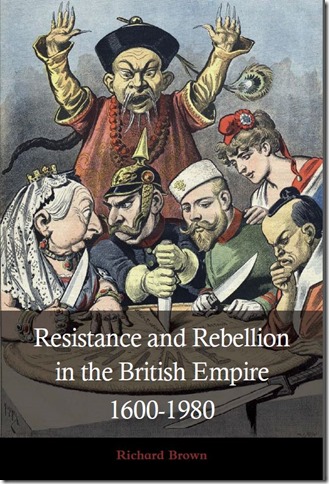Resistance and Rebellion in the British Empire 1600-1980, Richard Brown, Clio Publishing, 2013, paperback, 626 pp., £27.95 ISBN 9780955698385
Susan England of Clio, in an unusual, but entirely appropriate, appreciation of the author by the publisher in a foreword to this final volume of Richard Brown’s remarkable trilogy of studies of resistance and rebellion in the British Empire, completed since his retirement from full-time teaching, observes that the recent recognition by the High Court in London in October 2012 of the case of three veteran survivors of the ‘systematic torture, incarceration and killing’ allegedly meted out by the British colonial powers in Kenya during the seven-year Mau-Mau rebellion in the 1950s, provides an ever-present reminder of the continuing resonance of the experience of empire in our world today. This third volume of Brown’s epic trilogy breaks the chronological mould of volumes 1 and 2, which focused predominantly on developments in Britain, Canada and Australia in the six decades extending from the 1830s to the 1880s. By contrast to its predecessors, it ‘explores a diverse range of anti-colonial rebellions within the British Empire from a broader chronological and geographical perspective’ utilising case studies from the seventeenth to the twentieth centuries drawn from a gazetteer encompassing America, Australia, Cyprus, Kenya, Mauritius, New Zealand, Sierra Leone and South Africa, including some names more familiar to philatelists than to many students of history, all of which challenged at some point British imperial rule. The rebellions are crisply categorised as convict, migrant, fiscal, millenarian, nationalist and even a rum rebellion.
This latter, ‘very British rebellion’, occurring unusually within the colonial elite, and so-called because rum had become the substitute for currency in the barter-based economy of New South Wales, is particularly memorable since it challenged the authority of Captain William Bligh, the survivor of the mutiny of the Bounty in 1789 led by Fletcher Christian, the ship’s first mate. Bligh who in this later episode, lucidly and meticulously reconstructed by Brown, mainly from the contemporary evidence of Bligh’s correspondence and worthy perhaps of a cinematic sequel, was imprisoned from 1808 to 1810 by mutinous soldiers, but later exonerated of all blame and promoted admiral on his retirement in 1811. Brown’s characteristically trenchant analysis of Bligh’s conduct, however, reveals that even before his arrival as governor of the New South Wales penal colony, his style of governance had led to problems with his subordinates on the voyage, and that soon after his arrival he replaced many of the officials with military experience with his own appointments which ‘did not play well in a small community and did not endear him to the corps’. Indeed, he then proceeded to antagonise not only influential figures in the colony but also some of the less wealthy government leasehold tenants within Sydney, challenging their property rights and also gaining a reputation for ‘his abusing and confining’ the soldiers of the New South Wales Corps ‘without the smallest provocation’. This prompted John Harris, the corps’ surgeon who had been dismissed from his positions of naval officer and magistrate to compare his exercise of authority to that of Robespierre or the Terror or even the Roman emperor, Caligula, who ‘never reigned with more despotic sway than he does’. Meanwhile, in Sydney a verse was circulating, invoking the Bounty mutiny, appealing: ‘Is there no Christian in New South Wales to put a stop to the Tyranny of the Governor’.
Brown’s vivid analytical narrative, here as elsewhere, illuminates a relatively obscure episode of imperial history within a broader, carefully researched, wide-ranging study of anti-colonial resistance and rebellion. The publisher Clio and author Richard Brown are to be congratulated on producing such a wide-ranging concluding volume to a stimulating series in such an attractive format, which has the potential to engage with a wider student and general readership than might previously have been attracted to the study of British imperial history.

No comments:
Post a Comment